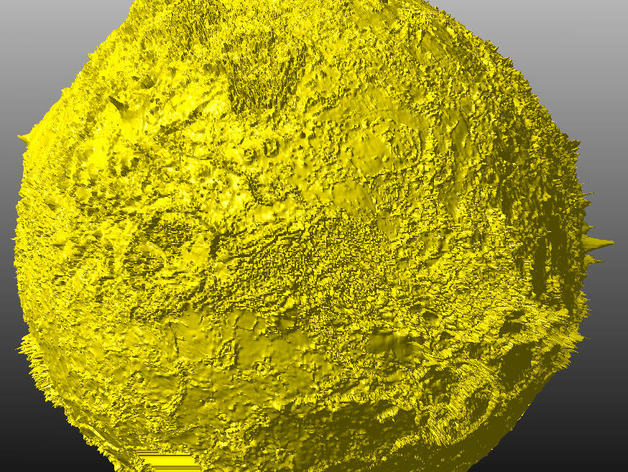
Venus 150x in 2 Million Facets
thingiverse
This Venus Globe has all clouds removed to show an exaggerated version of Venus' landscapes. The elevations from NASA Magellan and Pioneer spececraft have some missing data, so I took the data from the Soviet Union's Venera spacecraft and filled the globe completely. The Venera data has 1 degree grid and the Magellan data is using a 1/4 degree grid. The 150 factor for exaggerated elevations makes the peaks, like Maat Mons and Skadi Mons look very tall. If those names are unfamiliar to you, just google it to see 2D pictures. Or use this 3D sculpture to educate yourself. The pictures include the 150x and a 7x globe for comparison. On the 7x exaggeration picture, see the diagonal textured lines? They are real landforms called Textured Terrain. That is not an error.http://www.nytimes.com/1990/09/26/us/spacecraft-s-images-of-venus-s-terrain-astonish-scientists.html SPACECRAFT_NAME = MAGELLAN TARGET_NAME = VENUS OBJECT = TEXT PUBLICATION_DATE = 1991-12-31 BYTES = 80 NOTE = "MIT-MGN-GxDR v 2.3 Software Interface Specification" END_OBJECT = TEXT END M.I.T. Center for Space Research The radar reflectivity rho' is computed from the sum of two factors, rho derived from the strength of altimetry echoes, and rhocor, a correction due to diffuse scattering that is derived from the SAR backscatter cross-section. These parameters were taken from the ar_rho and ar_rhocor fields of altimetry data files in the ARCDR product. To compensate for the latitudinal error, all rho values were multiplied by an 8th order latitude-dependent polynomial rho' = rho*(p0+x*(p1+x*(p2+x*(p3+...))))/p0 + rhocor where x = (lat-lat0)/90, lat0 = periapsis latitude (~10N), and p0 = 0.110826 p1 = -0.0135412 p2 = -0.241179 p3 = -0.0103096 p4 = 1.55816 p5 = -0.130031 p6 = -2.08811 p7 = 0.242347 p8 = 0.962462 The polynomial coefficients p0 through p8 have been adjusted to retain the same average rho at all latitudes, ignoring areas known to possess anomalous reflectivity (Maxwell Montes, Beta Regio, and Aphrodite Terra). DATA_SET_RELEASE_DATE = 1992-01-15 PROCESSING_LEVEL_ID = 5 PRODUCER_FULL_NAME = 'Peter G. Ford' PRODUCER_INSTITUTION_NAME = "Massachusetts Institute of Technology" SOFTWARE_FLAG = N DETAILED_CATALOG_FLAG = N PROCESSING_START_TIME = 1991-06-24T20:11:00 PROCESSING_STOP_TIME = 1992-12-04T00:55:49 DATA_SET_DESC = "Global Topographic Data Record (GTDR). Alan Folmsbee writes: "I predict that standing stones will be found on Venus. The thick atmosphere slows down meteorites so they make a slow landing. The meteorites stand on the surface, intact." Instructions The Sinusoidal data files were re-sampled to make an array of elevations. Here is the link to all data for Venus that I used:http://pds-geosciences.wustl.edu/mgn/mgn-v-gxdr-v1/mg_3002/gtdr/sinus/ Re-sample that data so the sinusoidal projection is put into an array like Mars was. sub resample4 { $count_re = 0; for ($row=1; $row
With this file you will be able to print Venus 150x in 2 Million Facets with your 3D printer. Click on the button and save the file on your computer to work, edit or customize your design. You can also find more 3D designs for printers on Venus 150x in 2 Million Facets.
